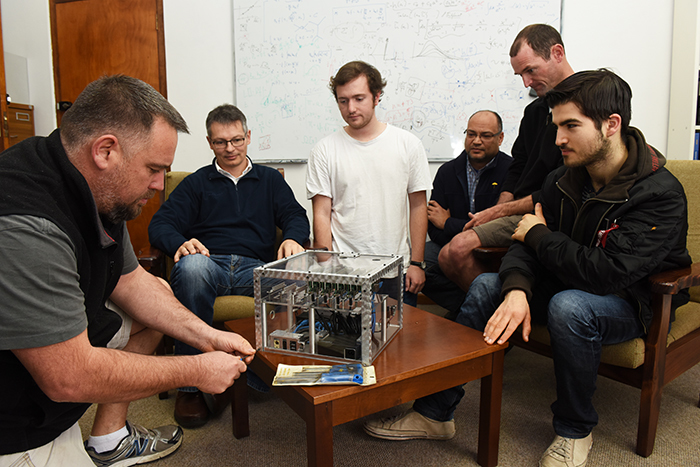Physics team builds mini supercomputer
27 August 2015 | Story by Newsroom
A team of students and staff from the physics department recently built a "mini supercomputer" from scratch.
The computer was dubbed 'Hi-Π-4-mens', as it operates on the same parallel-computing principles as high-performance computing centres, just on a much smaller scale. It makes use of a cluster of Raspberry-Pi computer boards similar to the hardware in smart phones.
Professor Andre Peshier of the Department of Physics explains: "I want to get students involved in research early on, and illustrate to them the interdisciplinary nature of our field. So, I proposed a project at the interface of physics and computer science, which needed to be solved on a DIY computer cluster. This hardware running parallel code allows for an elegant solution of the specific physics question I posed."
Information on a handful of similar hardware projects at overseas universities was very limited, so the process of designing, building, programming, and finally using the 'Hi-π-4-mens' cluster has been an incredible learning experience for the (now) second-year physics students Trystan Lambert and Victor Gueorguiev. With advice from Clint Sadler and Kerwin Ontong from the department's electronics workshop, Lambert focused on the hardware and set up the Giga-network linking the boards, while Gueorguiev focused mainly on developing the software for the project.
Intense discussions on the housing structure of the prototype, between the group and the mechanical workshop's James Dickson, led to a beautiful transparent design, making it literally a showcase for collaboration across all levels in the physics department.
Said the two students: "It was a fun and very interesting experience. Although at first it was scary, as we were thrown in the deep end and knew very little about parallel computing, we managed to make it happen and learned a lot along the way."
Peshier adds: "With 4+1 Raspberry-Pi boards at present, each costing around R400, our 'Hi-π-4-mens' cluster does not really reach the computing power of a typical personal computer, but it is considerably cheaper."
More important, however, is its value as a training vehicle. The cluster allows students to gain expertise in operating multi-processor computers, with full responsibility at all levels.
"This is essential in order to solve some of the complex questions being investigated in our department, many of them closely linked to CERN, the European Organization for Nuclear Research," says Peshier.
In future, he would like to fuel the physics department's undertaking to teach numerical modelling of systems using computers in its main first-year course. Students who excel in the regular Python programming tasks may now develop parallelised code on the cluster, or even start learning the more powerful mathematical framework.
Any applications for suitable projects, possibly also from other departments, should be submitted to Andre.Peshier@uct.ac.za.
Story by Katherine Wilson. Photo by Michael Hammond.
 This work is licensed under a Creative Commons Attribution-NoDerivatives 4.0 International License.
This work is licensed under a Creative Commons Attribution-NoDerivatives 4.0 International License.
Please view the republishing articles page for more information.










